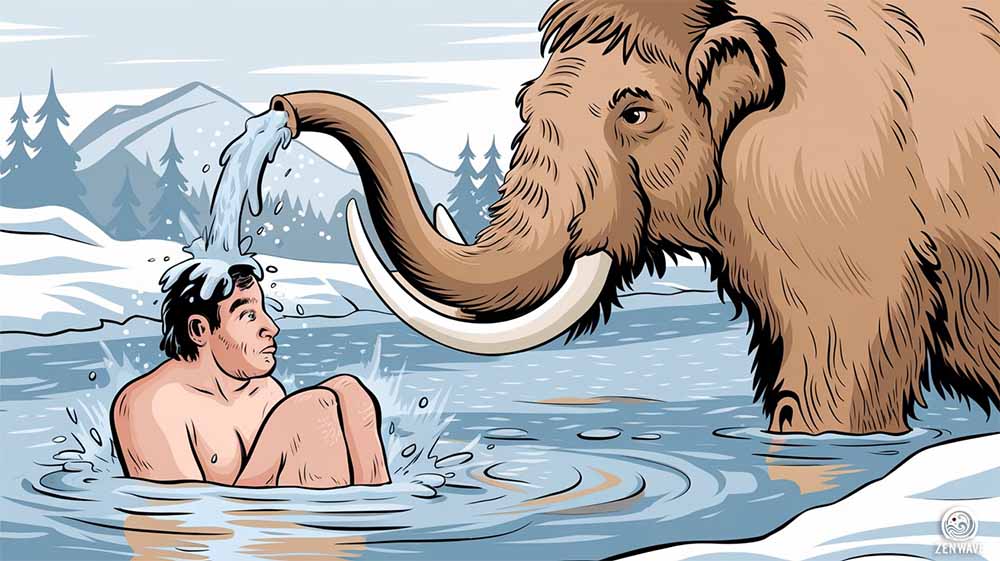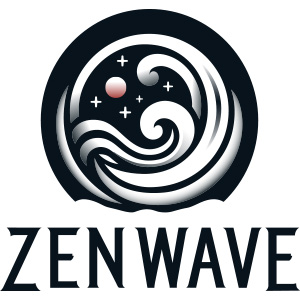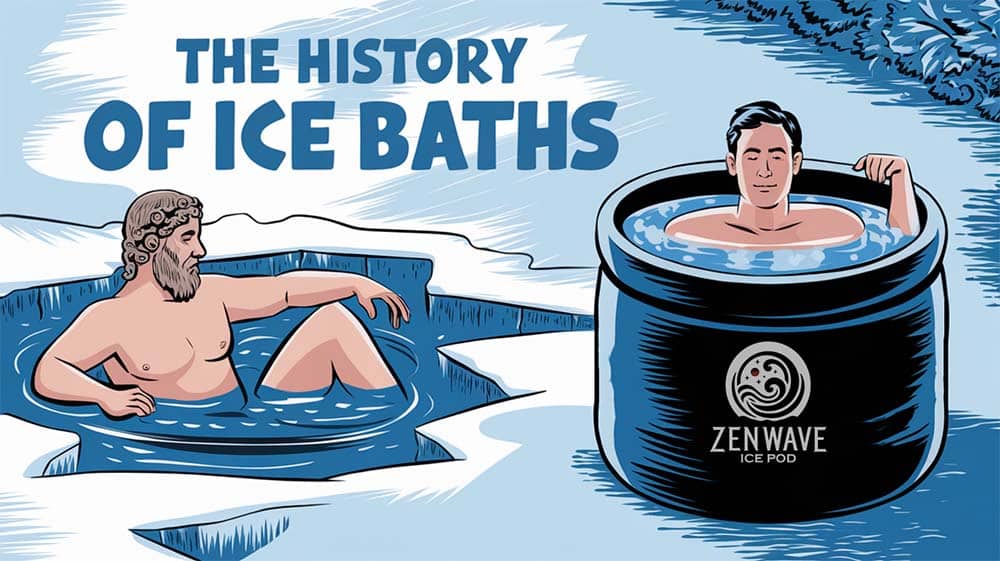Ice baths, or cold water immersion, have a rich history spanning thousands of years. This therapeutic practice has evolved from accidental discoveries by our prehistoric ancestors to a scientifically studied wellness technique.
Throughout history, diverse cultures have incorporated cold water therapy into their healing traditions, religious rituals, and athletic training. From ancient Egyptian medical texts to Greek and Roman bathhouses, from Ayurvedic practices to Japanese onsen culture, the use of cold water for health has been a constant across civilizations.
This article traces the journey of ice baths from their prehistoric roots to their modern applications, exploring how this age-old practice continues to adapt to contemporary needs while maintaining its core principles of promoting physical and mental well-being.
Prehistoric Roots (10,000 BCE – 3000 BCE)

Nature’s Cold Therapy
Long before recorded history, our ancestors likely discovered the invigorating and numbing effects of cold water by accident. Imagine early humans plunging into icy streams after a hunt or injury, experiencing the body’s natural response to cold shock. These encounters may have laid the groundwork for intentional cold-water therapies.
Shamanic Practices
Evidence suggests that shamans and healers in various cultures incorporated cold-water immersion into their rituals. These practices were often tied to purification, spiritual awakening, or tests of endurance. In Scandinavia, for instance, Norse warriors were said to plunge into icy fjords to prove their mettle and connect with their gods.
Ancient Civilizations (3000 BCE – 500 CE)
Egyptian Innovations
The Edwin Smith Papyrus, an ancient Egyptian medical text dating back to 1600 BCE, contains one of the earliest written references to cold therapy. Egyptian physicians recommended cold compresses for injuries, recognizing the anti-inflammatory properties of low temperatures.
Greco-Roman Refinement
The Greeks and Romans elevated cold-water therapy to an art form. Public bathhouses featured frigidaria, cold pools designed to invigorate the body after hot baths. Athletes in ancient Olympic games used cold-water immersion to enhance performance and recovery. The famous physician Hippocrates prescribed cold baths for various ailments, stating, “The bath should be quick, the immersion sudden.”
Eastern Traditions (1000 BCE – Present)
Ayurvedic Wisdom
In India, Ayurvedic medicine has long recognized the therapeutic potential of temperature extremes. Practitioners recommended alternating hot and cold baths to improve circulation and boost immunity. This concept of contrast therapy continues to influence modern hydrotherapy techniques.
Japanese Onsen Culture
Japan’s tradition of hot spring bathing also includes cold-water immersion. Some onsen feature rotenburo, outdoor baths that remain chilly even in winter. Alternating between hot and cold baths is believed to offer numerous health benefits and is deeply ingrained in Japanese bathing culture.
Modern Rediscovery (19th – Early 20th Century)
The 19th century saw a revival of interest in various cold-water therapies in the Western world. Victorian-era physicians like John Floyer (1649-1734) championed the health benefits of cold bathing, leading to the establishment of numerous hydrotherapy clinics across Europe and America. These practitioners observed improved circulation and vitality in their patients, effects that modern science has since validated.
The early 20th century witnessed the formation of “Polar Bear Clubs” in various countries. These groups celebrated the bracing effects of cold-water swimming, often taking winter dips in lakes, rivers, and oceans. The Coney Island Polar Bear Club, founded in 1903, continues this tradition to this day.
Scientific Validation
Sports Science Revolution
The late 20th and early 21st centuries brought scientific scrutiny to cold-water immersion. Researchers began studying the physiological effects of ice baths on athletic performance and recovery. This led to the widespread adoption of ice baths in professional sports, with athletes from various disciplines incorporating them into their training regimens. Studies have shown that cold water immersion can reduce muscle soreness, decrease inflammation, and potentially speed up recovery time.
Therapeutic Applications
Beyond athletics, researchers are exploring the potential of cold-water immersion for treating conditions ranging from depression to chronic pain. The practice of “cold thermogenesis” – intentional cold exposure for health benefits – has gained popularity among biohackers and wellness enthusiasts.
Ice Baths Today
As we’ve seen throughout history, the practice of cold water immersion has continually evolved to meet the needs and understanding of each era. Today, this ancient therapy is finding new life in modern homes, thanks to innovations like the ZenWave Ice Pod.
The ZenWave Ice Pod represents the latest step in the long journey of cold water therapy. This portable ice bath brings the benefits of cold immersion directly into people’s homes, much like how the Romans brought cold pools into their bath complexes or how Victorian physicians established hydrotherapy clinics. Key features include:
- Convenient at-home cold therapy
- A controlled environment for precise temperature management
- Adaptability for indoor or outdoor use
- Support for gradual cold exposure adaptation
By making cold water immersion more accessible, devices like the ZenWave Ice Pod continue the tradition of adapting this practice to contemporary needs while honoring its rich history.
As we conclude our journey through the frosty annals of ice bath history, we see a practice that has stood the test of time. From prehistoric humans discovering the invigorating effects of cold streams to ancient Egyptians documenting cold therapies, from Greek athletes enhancing their performance to Japanese onsen culture embracing temperature contrasts, the use of cold water for health and wellness has been a constant thread in human civilization.

